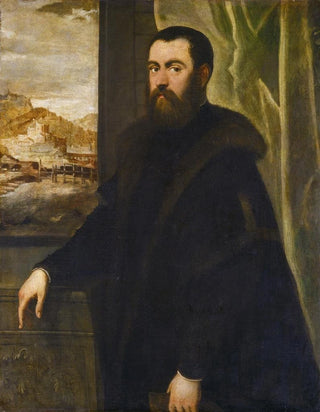Art print | Portrait of a man with a view of a landscape - Jacopo Tintoretto


View from behind

Frame (optional)
The "Portrait of a Man with a View of a Landscape" by Jacopo Tintoretto is an iconic work that transcends the simple frame of a portrait to immerse us in an atmosphere rich in emotion and reflection. Created in the 16th century, this piece showcases the mastery of the Venetian painter, whose bold style and innovative technique continue to inspire art enthusiasts. Through this painting, Tintoretto invites the viewer to contemplate not only the face of his subject but also the landscape extending behind him, thus creating a dialogue between man and nature. This portrait, imbued with mystery, challenges us and encourages us to explore the thoughts and feelings of the figure before us.
Style and uniqueness of the work
Tintoretto's style is characterized by unparalleled dynamism and expressiveness. In this work, he manages to capture the personality of his subject with remarkable precision while incorporating landscape elements that enrich the composition. The play of light and shadow, typical of his approach, gives the scene a striking depth. The vibrant colors and bold brushstrokes are orchestrated to create an atmosphere that is both intimate and grandiose. The gaze of the character, both thoughtful and penetrating, seems to tell us a story, while the landscape in the background, with its delicate nuances, evokes a sense of serenity. This fusion between portrait and landscape demonstrates Tintoretto's skill in establishing emotional connections between the artwork and the viewer.
The artist and his influence
Jacopo Tintoretto, often regarded as one of the greatest masters of Venetian painting, left his mark on his era with his innovative approach and ability to blend tradition and modernity. Born in 1518, he managed to establish himself in an artistic environment dominated by figures such as Titian and Veronese. His technique, which favors movement and energy, paved the way for new forms of artistic expression. Tintoretto not only influenced his contemporaries but also left an indelible mark on

Matte finish

View from behind

Frame (optional)
The "Portrait of a Man with a View of a Landscape" by Jacopo Tintoretto is an iconic work that transcends the simple frame of a portrait to immerse us in an atmosphere rich in emotion and reflection. Created in the 16th century, this piece showcases the mastery of the Venetian painter, whose bold style and innovative technique continue to inspire art enthusiasts. Through this painting, Tintoretto invites the viewer to contemplate not only the face of his subject but also the landscape extending behind him, thus creating a dialogue between man and nature. This portrait, imbued with mystery, challenges us and encourages us to explore the thoughts and feelings of the figure before us.
Style and uniqueness of the work
Tintoretto's style is characterized by unparalleled dynamism and expressiveness. In this work, he manages to capture the personality of his subject with remarkable precision while incorporating landscape elements that enrich the composition. The play of light and shadow, typical of his approach, gives the scene a striking depth. The vibrant colors and bold brushstrokes are orchestrated to create an atmosphere that is both intimate and grandiose. The gaze of the character, both thoughtful and penetrating, seems to tell us a story, while the landscape in the background, with its delicate nuances, evokes a sense of serenity. This fusion between portrait and landscape demonstrates Tintoretto's skill in establishing emotional connections between the artwork and the viewer.
The artist and his influence
Jacopo Tintoretto, often regarded as one of the greatest masters of Venetian painting, left his mark on his era with his innovative approach and ability to blend tradition and modernity. Born in 1518, he managed to establish himself in an artistic environment dominated by figures such as Titian and Veronese. His technique, which favors movement and energy, paved the way for new forms of artistic expression. Tintoretto not only influenced his contemporaries but also left an indelible mark on






